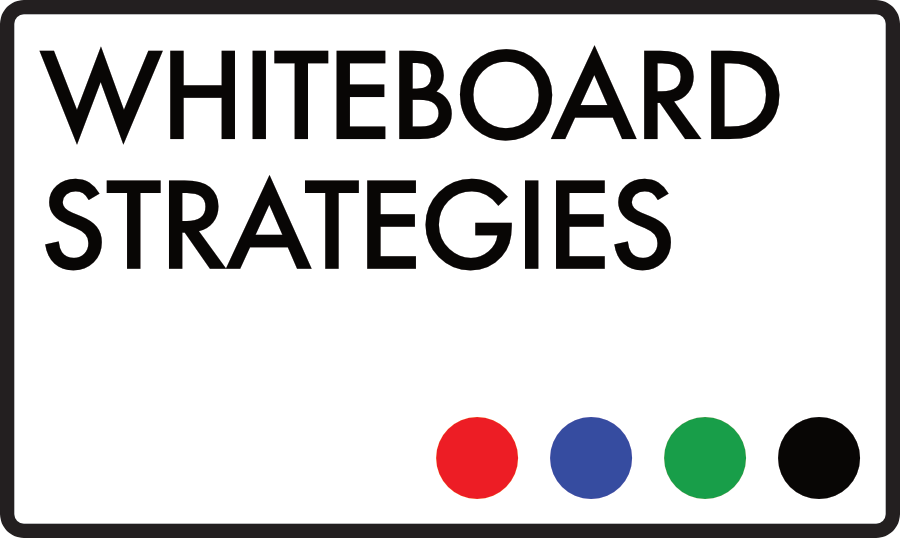There’s a huge area of visual communication in business that we haven’t touched on since the new Whiteboard Strategies site went live, and that’s video calls. People occasionally assume that I wouldn’t be a big fan of video calls, and I can see where they’re coming from—I often talk about the value of face time with customers, the benefits of physically being somewhere, the importance of presence in leading a conversation. Actually though, I think that the advent of reliable, mostly-lag-free video calling can be harnessed and utilised extremely effectively by sales leaders and sales teams… as long as they’re being taught the right way of doing it.
Depending on your organisation’s structure, the duty of ensuring that your teams are properly clued up with video calling etiquette will either fall on your enablement team or the responsible line managers, but ultimately the decision to train staff to harness the potential of video conferencing software – both for internal and client calls—should be made by members of the C-Suite. It’s that important to be getting it right, and that useful if they do.
The benefits of video calling are obvious—if your teams are based in London, a rep’s two hour face-to-face meeting with a client or colleague in New York can take two hours, rather than the few days you used to have to allow them to go over there. It streamlines workload, saves time, minimises financial outlays, and means that you can keep a close eye on your people. Perfect, right?
Well, sort of. There’s a hitch—lots of people are really, really bad at video calls. Here are some of the most common mistakes to talk over with your teams (or your enablement team, if you’re lucky enough to have one!).
1. Be Aware of Setting: I couldn’t count the number of video calls I’ve been on where the person I’m talking to just hasn’t thought about where they are and how it looks. The person on the other end of the call can’t just see your staff member, they can see where they are and what’s going on there. If your team call from the office, make sure the areas behind them are tidy, or think about providing a clear, clean space for making and receiving video calls. If they ever work from home, make sure they’ve had the importance of a proper setting drilled into them—I’ve talked to people who were sitting on their beds before, and obviously thought I couldn’t tell. I could.
2. Minimise Potential Interruptions: This is another really common one. It can be really damaging—an interruption at the wrong time (is there ever a right time?) can kill the momentum of even the most well rehearsed sales narrative or presentation, and give an impression of not being committed to a call. I’ve seen colleagues, dogs and family members all wander into the frame on video calls before now—and it never leaves a good impression.
3. Remember to Prepare: Video calls are great, because video calls are visual. That’s what a lot of these problems also stem from. Your staff need to be taught that preparation is key for video calls, precisely because the person they are talking to can see what they are doing. On a phone call they might just get away with rifling through paperwork, or frantically skimming through files on their screen whilst talking. On a video call that simply won’t wash.
4. Look in the Right Place: I’ve written about this tip before, but it’s a keeper. A rep should give the impression that they are looking at the person on the other end of the call. It’s easy to do—wherever the other person’s face pops up, they just need to move it to just under their camera. People – especially under-prepared people who need to file-skim while they speak—often move the other person’s window down to a lower corner, meaning that when the caller looks at that frame, it seems to the customer as if they are looking anywhere but at them.
5. Know your Software: Whether they’ll be using full video conferencing software in a dedicated suite, or a simple video calling program like Skype from their laptops or phones, your people need to know how to use the software. They don’t need intensive training that takes weeks, but they do need to know their way around. Too many video calls are undermined by people button mashing, asking ‘is this on…. can you hear me?’, accidentally muting themselves or others, lost connections and many more problems that are a direct result of not knowing the platform well enough.
Your people need to remember that the thing that makes video calling so effective is also the thing that makes them vulnerable to stupid errors: video calls are a fundamentally visual way of ‘meeting’ with someone. People need to approach them in the same way they would a meeting – so ensure that your teams are being taught to prepare for their calls properly, to be aware of themselves and their surroundings, and to treat the caller with the same courtesy and respect they would if they were sitting in a room with them.
Iron these creases out and you’ll feel the benefits of harnessing a way of communicating visually that has huge potential to improve communication, strengthen client relationships and boost bottom lines.

Recent Comments